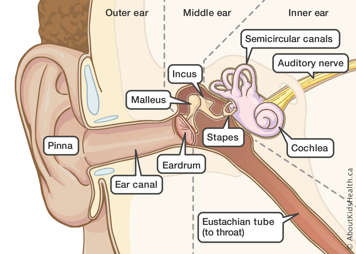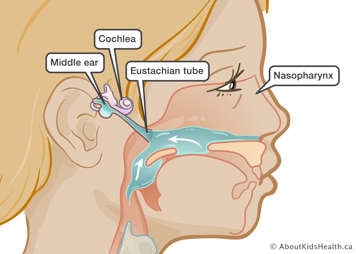Babies born with a cleft palate often have a conductive hearing loss due to the opening in their palate. This type of hearing loss is often temporary if it is managed correctly. Your baby will be seen regularly by an audiologist to monitor their hearing. Audiologists are health-care professionals who specialize in hearing and balance difficulties.
Ear anatomy
The ear is made up of three main parts:
- The outer ear: The outside of the ear (pinna) captures sounds and funnels them down the ear canal all the way to the eardrum.
- The middle ear: Has several parts. The first part, the eardrum, vibrates when the sound reaches it. This vibration causes the three tiny bones behind the eardrum to move. Another part of the middle ear is the eustachian tube. This tube connects the middle ear to the upper throat and the back of the nose.
- The inner ear: The cochlea is part of the inner ear and is known as the hearing organ. There are cells in the cochlea that vibrate when stimulated by different sounds. When these cells vibrate, a signal is sent to the auditory nerve which carries the sounds up to the brain.

Ontario Infant Hearing Program (IHP)
All newborn babies in Ontario can have their hearing screened through IHP. An IHP screener or nurse will run a quick and automatic test in each ear that will provide the result of either ‘pass’ or ‘refer’. If your baby gets a:
- Pass: it is very likely all three sections of the ear are working well and there is a low chance of a hearing loss.
- Refer: additional testing is needed and your local IHP will arrange for a more thorough hearing test called an auditory brainstem response (ABR) test. This test measures the brain’s response to sound and checks the health of the entire auditory pathway.

Conductive hearing loss
Babies born with cleft palates are at a higher risk of developing a conductive hearing loss. Mucus or congestion from the mouth and nose can travel through the opening in the palate and along the eustachian tube up into the middle ear. Fluid can then build up in the middle ear space. When this happens, sound cannot reach the cochlea as well as it normally does and can result in what is called a conductive hearing loss. A conductive hearing loss caused by fluid will generally range from mild to moderate in degree. Everyday speech may sound a little muffled.
If a conductive hearing loss is identified, a ventilation tube may be inserted into the eardrum to drain out the middle ear space. If this is recommended, it is usually done during the cleft palate repair by an ear, nose and throat (ENT) doctor when your child is around 12 months of age. With the tube in place, hearing often improves. The tube is tiny and usually falls out on its own in 6 to 12 months. The hole in the eardrum will naturally heal and close on its own.
Even if your baby passes the IHP hearing screen, they are still at a higher risk of developing a conductive hearing loss compared to babies without a cleft palate. Not all babies with cleft palates require tubes, however, their hearing will still be monitored in case of any fluid buildup.
Follow-up appointments
Your child will continue to have regular audiology follow-up appointments. Follow-up is to monitor your child’s hearing and to make sure they continue to have good access to sounds from both ears as they continue to develop.
- Birth: Newborn hearing screen (local IHP)
- Pass: Follow-up around 9+ months (scheduled by CLP Program)
- Refer: Immediate follow-up (scheduled by IHP)
- 9+ months old: Pre-palate repair hearing test (scheduled by CLP Program)
- 15 to 18 months old: Post-palate repair hearing test (scheduled by CLP Program in coordination with local IHP)
Follow-up hearing tests for your child will be scheduled by the CLP Program at the same time as their ENT appointments. Regular audiology monitoring can often be arranged locally and closer to home to minimize travel to and from the hospital.